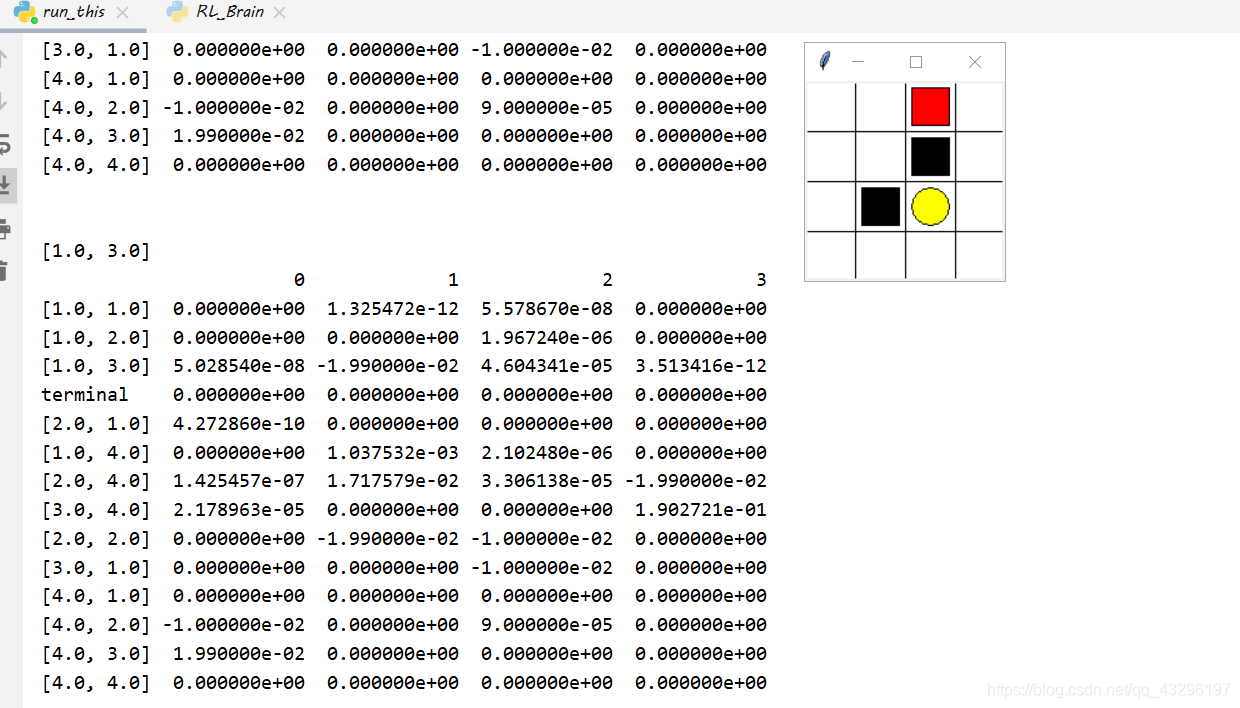
maze_env.py
"""
Reinforcement learning maze example.
Red rectangle: explorer.
Black rectangles: hells [reward = -1].
Yellow bin circle: paradise [reward = +1].
All other states: ground [reward = 0].
This script is the environment part of this example. The RL is in RL_brain.py.
View more on my tutorial page: https://morvanzhou.github.io/tutorials/
"""
import numpy as np
import time
import sys
if sys.version_info.major == 2:
import Tkinter as tk
else:
import tkinter as tk
UNIT = 40 # pixels
MAZE_H = 4 # grid height
MAZE_W = 4 # grid width
class Maze(tk.Tk, object):
def __init__(self):
super(Maze, self).__init__()
self.action_space = ['u', 'd', 'r', 'l']
self.n_actions = len(self.action_space)
self.title('maze')
self.geometry('{0}x{1}'.format(MAZE_H * UNIT, MAZE_H * UNIT))
self._build_maze()
self.TTime=.2
def _build_maze(self):
self.canvas = tk.Canvas(self, bg='white',
height=MAZE_H * UNIT,
width=MAZE_W * UNIT)
# create grids
for c in range(0, MAZE_W * UNIT, UNIT):
x0, y0, x1, y1 = c, 0, c, MAZE_H * UNIT
self.canvas.create_line(x0, y0, x1, y1)
for r in range(0, MAZE_H * UNIT, UNIT):
x0, y0, x1, y1 = 0, r, MAZE_W * UNIT, r
self.canvas.create_line(x0, y0, x1, y1)
# create origin
origin = np.array([20, 20])
# hell
hell1_center = origin + np.array([UNIT * 2, UNIT])
self.hell1 = self.canvas.create_rectangle(
hell1_center[0] - 15, hell1_center[1] - 15,
hell1_center[0] + 15, hell1_center[1] + 15,
fill='black')
# hell
hell2_center = origin + np.array([UNIT, UNIT * 2])
self.hell2 = self.canvas.create_rectangle(
hell2_center[0] - 15, hell2_center[1] - 15,
hell2_center[0] + 15, hell2_center[1] + 15,
fill='black')
# create oval
oval_center = origin + UNIT * 2
self.oval = self.canvas.create_oval(
oval_center[0] - 15, oval_center[1] - 15,
oval_center[0] + 15, oval_center[1] + 15,
fill='yellow')
# create red rect
self.rect = self.canvas.create_rectangle(
origin[0] - 15, origin[1] - 15,
origin[0] + 15, origin[1] + 15,
fill='red')
# pack all
self.canvas.pack()
def reset(self):
self.update()
time.sleep(self.TTime)
self.canvas.delete(self.rect)
origin = np.array([20, 20])
self.rect = self.canvas.create_rectangle(
origin[0] - 15, origin[1] - 15,
origin[0] + 15, origin[1] + 15,
fill='red')
# return observation
return self.canvas.coords(self.rect)
def step(self, action):
s = self.canvas.coords(self.rect)
base_action = np.array([0, 0])
if action == 0: # up
if s[1] > UNIT:
base_action[1] -= UNIT
elif action == 1: # down
if s[1] < (MAZE_H - 1) * UNIT:
base_action[1] += UNIT
elif action == 2: # right
if s[0] < (MAZE_W - 1) * UNIT:
base_action[0] += UNIT
elif action == 3: # left
if s[0] > UNIT:
base_action[0] -= UNIT
self.canvas.move(self.rect, base_action[0], base_action[1]) # move agent
s_ = self.canvas.coords(self.rect) # next state
# reward function
if s_ == self.canvas.coords(self.oval):
reward = 1
done = True
s_ = 'terminal'
elif s_ in [self.canvas.coords(self.hell1), self.canvas.coords(self.hell2)]:
reward = -1
done = True
s_ = 'terminal'
else:
reward = 0
done = False
return s_, reward, done
def render(self):
time.sleep(self.TTime)
self.update()
def update():
for t in range(10):
s = env.reset()
while True:
env.render()
a = 1
s, r, done = env.step(a)
if done:
break
if __name__ == '__main__':
env = Maze()
env.after(100, update)
env.mainloop()
RL_Brain.py
"""
This part of code is the Q learning brain, which is a brain of the agent.
All decisions are made in here.
View more on my tutorial page: https://morvanzhou.github.io/tutorials/
"""
import numpy as np
import pandas as pd
class QLearningTable:
def __init__(self, actions, learning_rate=0.01, reward_decay=0.9, e_greedy=0.9):
self.actions = actions # a list 传入的actions为[0, 1, 2, 3]
self.lr = learning_rate
self.gamma = reward_decay
self.epsilon = e_greedy
self.q_table = pd.DataFrame(columns=self.actions, dtype=np.float64)
def choose_action(self, observation): # 在当前位置选择一个action
#observation = str([((float(observation[1]) - 5) / 40 + 1), ((float(observation[0]) - 5) / 40 + 1)])
self.check_state_exist(observation) # 判断当前位置是否存在在Q-table中,若不存在则创建
# action selection
if np.random.uniform() < self.epsilon:
# choose best action
state_action = self.q_table.loc[str(observation), :]
# some actions may have the same value, randomly choose on in these actions
action = np.random.choice(state_action[state_action == np.max(state_action)].index)
else:
# choose random action
action = np.random.choice(self.actions)
return action
def learn(self, s, a, r, s_):
#s=str(s)
#s_=str(s_)
print(s_)
self.check_state_exist(s_)
q_predict = self.q_table.loc[s, a]
if s_ != 'terminal':
q_target = r + self.gamma * self.q_table.loc[s_, :].max() # next state is not terminal
else:
q_target = r # next state is terminal
self.q_table.loc[s, a] += self.lr * (q_target - q_predict) # update
print(self.q_table)
print('\n')
def check_state_exist(self, state):
if (state) not in self.q_table.index:
# append new state to q table
#print(state)
# print(state.type())
#print(state[6])
#print(str([((float(state[6])-5)/40+1),((float(state[1])-5)/40+1)]))
if(state=='terminal'):
print('aaaa')
self.q_table = self.q_table.append(
pd.Series(
[0]*len(self.actions), # 4个0
index=self.q_table.columns,
name=(state),
#name=str([((float(state[6])-5)/40+1),((float(state[1])-5)/40+1)]),
)
)
# print(self.q_table.columns)
run_this.py
"""
Reinforcement learning maze example.
Red rectangle: explorer.
Black rectangles: hells [reward = -1].
Yellow bin circle: paradise [reward = +1].
All other states: ground [reward = 0].
This script is the main part which controls the update method of this example.
The RL is in RL_brain.py.
View more on my tutorial page: https://morvanzhou.github.io/tutorials/
"""
from maze_env import Maze
from RL_Brain import QLearningTable
def update():
for episode in range(100):
# initial observation
observation = env.reset() # 每一个回合从原点出发
while True:
# fresh env
env.render()
# print(observation)
#print('a')
# RL choose action based on observation(observation指的是当前位置是哪一个方块)
if(observation != 'terminal'):
trans_observation=str([((float(observation[1]) - 5) / 40 + 1), ((float(observation[0]) - 5) / 40 + 1)])
else:
trans_observation=observation#print('observation=ter')
action = RL.choose_action((trans_observation))
# RL take action and get next observation and reward
observation_, reward, done = env.step(action) # 进入黑色空间或者目标时候 表示游戏结束 done=Ture
if (observation_ != 'terminal'):
trans_observation_=str([((float(observation_[1]) - 5) / 40 + 1), ((float(observation_[0]) - 5) / 40 + 1)])
# RL learn from this transition
else:
trans_observation_=observation_#print(observation_)
RL.learn(trans_observation, action, reward, trans_observation_)
# swap observation
observation = observation_
# print(observation)
# break while loop when end of this episode
if done:
break
# end of game
print('game over')
env.destroy()
if __name__ == "__main__":
env = Maze()
print(list(range(env.n_actions)))
RL = QLearningTable(actions=list(range(env.n_actions)))
env.after(100, update)
env.mainloop()
来源:CSDN
作者:宗介l
链接:https://blog.csdn.net/qq_43296197/article/details/104186257